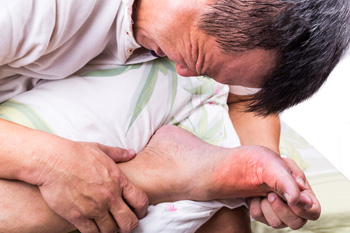Call Us Today! (203) 975-9600
SAME DAY APPOINTMENTS AVAILABLE
May 2025
Sever's Disease in Active Growing Children

Sever's disease is a common cause of heel pain in growing children, especially those who are physically active. It occurs when the growth plate in the heel becomes inflamed due to repetitive stress or pressure. This condition is most often seen during periods of rapid growth, when the bones, muscles, and tendons are changing quickly. Symptoms include pain in one or both heels, tenderness, and discomfort during or after physical activity. The pain may worsen with running or jumping and improve with rest. Risk factors include participation in sports that involve running, jumping, or wearing cleats, as well as having tight calf muscles or flat feet. If your active child has heel pain, it is suggested that you schedule an appointment with a podiatrist who can provide an accurate diagnosis and treatment.
Sever's disease often occurs in children and teens. If your child is experiencing foot or ankle pain, see one of our podiatrists from Preferred Footcare, LLC. Our doctors can treat your child’s foot and ankle needs.
Sever’s Disease
Sever’s disease is also known as calcaneal apophysitis, which is a medical condition that causes heel pain I none or both feet. The disease is known to affect children between the ages of 8 and 14.
Sever’s disease occurs when part of the child’s heel known as the growth plate (calcaneal epiphysis) is attached to the Achilles tendon. This area can suffer injury when the muscles and tendons of the growing foot do not keep pace with bone growth. Therefore, the constant pain which one experiences at the back of the heel will make the child unable to put any weight on the heel. The child is then forced to walk on their toes.
Symptoms
Acute pain – Pain associated with Sever’s disease is usually felt in the heel when the child engages in physical activity such as walking, jumping and or running.
Highly active – Children who are very active are among the most susceptible in experiencing Sever’s disease, because of the stress and tension placed on their feet.
If you have any questions, please feel free to contact our office located in Stamford, CT . We offer the newest diagnostic and treatment technologies for all your foot and ankle injuries.
When a Cut on the Foot Should Be Left Open

Not every foot cut needs to be covered all the time. In some cases, letting a minor wound breathe can help it to heal faster. Small, clean cuts without signs of infection may benefit from short periods of air exposure, which can dry the surface and support natural healing. However, this only applies when the area is protected from dirt, pressure, and further injury. Cuts in moist areas or places that rub against shoes should usually stay covered to avoid irritation. If a wound is deep, bleeding heavily or shows redness, swelling, or drainage, it should be kept clean, protected, and watched closely. People with diabetes or poor circulation should always cover foot cuts to reduce the risk of infection. If a cut on your foot does not heal or becomes painful, it is suggested you see a podiatrist for appropriate treatment.
Wound care is an important part in dealing with diabetes. If you have diabetes and a foot wound or would like more information about wound care for diabetics, consult with one of our podiatrists from Preferred Footcare, LLC. Our doctors will assess your condition and provide you with quality foot and ankle treatment.
What Is Wound Care?
Wound care is the practice of taking proper care of a wound. This can range from the smallest to the largest of wounds. While everyone can benefit from proper wound care, it is much more important for diabetics. Diabetics often suffer from poor blood circulation which causes wounds to heal much slower than they would in a non-diabetic.
What Is the Importance of Wound Care?
While it may not seem apparent with small ulcers on the foot, for diabetics, any size ulcer can become infected. Diabetics often also suffer from neuropathy, or nerve loss. This means they might not even feel when they have an ulcer on their foot. If the wound becomes severely infected, amputation may be necessary. Therefore, it is of the upmost importance to properly care for any and all foot wounds.
How to Care for Wounds
The best way to care for foot wounds is to prevent them. For diabetics, this means daily inspections of the feet for any signs of abnormalities or ulcers. It is also recommended to see a podiatrist several times a year for a foot inspection. If you do have an ulcer, run the wound under water to clear dirt from the wound; then apply antibiotic ointment to the wound and cover with a bandage. Bandages should be changed daily and keeping pressure off the wound is smart. It is advised to see a podiatrist, who can keep an eye on it.
If you have any questions, please feel free to contact our office located in Stamford, CT . We offer the newest diagnostic and treatment technologies for all your foot care needs.
Managing an Ingrown Toenail

An ingrown toenail occurs when the side or corner of the nail grows into the surrounding skin, often resulting in pain, redness, and swelling. This condition most commonly affects the big toe and can worsen if left untreated. A podiatrist can diagnose an ingrown toenail by examining the affected area and evaluating any signs of infection, such as pus, warmth, or foul odor. If an infection is present, antibiotics may be prescribed. In moderate to severe cases, a podiatrist may recommend surgery to remove a portion of the nail, a procedure known as a partial nail avulsion. Additional options like splinting or bracing may be used to help the nail grow in the correct direction. People with diabetes or poor circulation are at a higher risk for complications and should seek prompt medical care. If you have an ingrown toenail that is causing pain, it is suggested that you schedule an appointment with a podiatrist for appropriate treatment.
Ingrown toenails can become painful if they are not treated properly. For more information about ingrown toenails, contact one of our podiatrists of Preferred Footcare, LLC. Our doctors can provide the care you need to keep you pain-free and on your feet.
Ingrown Toenails
Ingrown toenails occur when a toenail grows sideways into the bed of the nail, causing pain, swelling, and possibly infection.
Causes
- Bacterial infections
- Improper nail cutting such as cutting it too short or not straight across
- Trauma to the toe, such as stubbing, which causes the nail to grow back irregularly
- Ill-fitting shoes that bunch the toes too close together
- Genetic predisposition
Prevention
Because ingrown toenails are not something found outside of shoe-wearing cultures, going barefoot as often as possible will decrease the likeliness of developing ingrown toenails. Wearing proper fitting shoes and using proper cutting techniques will also help decrease your risk of developing ingrown toenails.
Treatment
Ingrown toenails are a very treatable foot condition. In minor cases, soaking the affected area in salt or antibacterial soaps will not only help with the ingrown nail itself, but also help prevent any infections from occurring. In more severe cases, surgery is an option. In either case, speaking to your podiatrist about this condition will help you get a better understanding of specific treatment options that are right for you.
If you have any questions please feel free to contact our office located in Stamford, CT . We offer the newest diagnostic and treatment technologies for all your foot and ankle needs.
Are You Suffering From Ingrown Toenails?
Managing Painful Gout

Gout is a form of inflammatory arthritis that typically affects the joints in the feet, especially the big toe. It is caused by a buildup of uric acid in the blood, which forms sharp crystals in the joints. Gout can result from genetics, diet, especially foods high in purines like red meat and seafood, obesity, or certain medical conditions. Symptoms often appear suddenly and may include intense joint pain, redness, swelling, and warmth, especially at night. Many describe the pain as sharp, throbbing, or crushing, making walking or even the touch of a bedsheet unbearable. A podiatrist can diagnose gout through examination and imaging, and may recommend lifestyle changes, medications to lower uric acid levels, or anti-inflammatory treatments. In some cases, custom orthotics or joint care strategies may also help relieve pressure and prevent future flare-ups. If you have painful gout, it is suggested that you schedule an appointment with a podiatrist.
Gout is a foot condition that requires certain treatment and care. If you are seeking treatment, contact one of our podiatrists from Preferred Footcare, LLC. Our doctors will treat your foot and ankle needs.
What Is Gout?
Gout is a type of arthritis caused by a buildup of uric acid in the bloodstream. It often develops in the foot, especially the big toe area, although it can manifest in other parts of the body as well. Gout can make walking and standing very painful and is especially common in diabetics and the obese.
People typically get gout because of a poor diet. Genetic predisposition is also a factor. The children of parents who have had gout frequently have a chance of developing it themselves.
Gout can easily be identified by redness and inflammation of the big toe and the surrounding areas of the foot. Other symptoms include extreme fatigue, joint pain, and running high fevers. Sometimes corticosteroid drugs can be prescribed to treat gout, but the best way to combat this disease is to get more exercise and eat a better diet.
If you have any questions please feel free to contact our office located in Stamford, CT . We offer the newest diagnostic and treatment technologies for all your foot and ankle needs.









